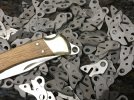MT_Pokt
Gold Member
- Joined
- Jul 21, 2014
- Messages
- 2,525
As promised...
*Spoiler alert* This knife is awesome!
This is no conversion. This is a purpose built auto. Everything about it is tight, clean, and beautiful. A fair amount of thought went into this design. Anyone can build an auto from scratch, but to take something as primitive (and iconic) as a 110 and make a dependable auto that maintains the traditional lines was no easy task. Think about it... all of those 110 auto conversions out there have no factory warranty, will never receive factory service, and cost similar money!
Coil spring in a machined receptacle in the bolsters? Yeah... done right!
Minutiae time...
Starting at the blade, the choil is ground / chamfered so that it doesn't hang up on the release tab when closing.

Here you can see how it interacts with the tab (blade is at 90 degrees)

Here's the back side of the front liner. Cut out for clearance for the button. The button is rocker type that appears to be fastened to the liner, but could be fastened on the bottom side of the front bolster. I'll have something definitive on this later.

The two scale pins ahead of the button could serve a couple of different purposes. Of course they hold the scale on, but they also protect the button.

The height of the button is barely higher than the pin heads. I like to think it was planned this way.

What was a pleasant surprise was finding that this is no hair trigger. You have to depress the button to what seems like below the surface of the scale, and because it's not a very large button, accidental deployment should be rare.
Well... apparently I don't have a photo for this...
Here's the auto (top) with a standard 2017 110 (bottom). Dimensionally, they're the same, or within the same tolerances. One thing that I'm curious about is the square spring bar on the auto. The standard springs are round bar. Tension from the stock round spring is pretty mild, so perhaps they used a heavier one to maintain more pressure on the tab that holds the blade shut. This would explain why the button is a little stiff.

I have 2 questions for Jeff Hubbard.
1- Do these 2 pins ahead of the button serve any purpose other than to hold the scale on?
2- Is the rear spacer/spring holder the same as a standard 110 and just the spring is different? (I'm going to find out anyway when I put a lanyard on it. )
)
If it's the same spring holder, and the front pins do nothing but hold the scales on, I'm thinking some mammoth ivory would look good on this...

*Spoiler alert* This knife is awesome!
This is no conversion. This is a purpose built auto. Everything about it is tight, clean, and beautiful. A fair amount of thought went into this design. Anyone can build an auto from scratch, but to take something as primitive (and iconic) as a 110 and make a dependable auto that maintains the traditional lines was no easy task. Think about it... all of those 110 auto conversions out there have no factory warranty, will never receive factory service, and cost similar money!
Coil spring in a machined receptacle in the bolsters? Yeah... done right!
Minutiae time...
Starting at the blade, the choil is ground / chamfered so that it doesn't hang up on the release tab when closing.

Here you can see how it interacts with the tab (blade is at 90 degrees)

Here's the back side of the front liner. Cut out for clearance for the button. The button is rocker type that appears to be fastened to the liner, but could be fastened on the bottom side of the front bolster. I'll have something definitive on this later.

The two scale pins ahead of the button could serve a couple of different purposes. Of course they hold the scale on, but they also protect the button.

The height of the button is barely higher than the pin heads. I like to think it was planned this way.

What was a pleasant surprise was finding that this is no hair trigger. You have to depress the button to what seems like below the surface of the scale, and because it's not a very large button, accidental deployment should be rare.
Well... apparently I don't have a photo for this...
Here's the auto (top) with a standard 2017 110 (bottom). Dimensionally, they're the same, or within the same tolerances. One thing that I'm curious about is the square spring bar on the auto. The standard springs are round bar. Tension from the stock round spring is pretty mild, so perhaps they used a heavier one to maintain more pressure on the tab that holds the blade shut. This would explain why the button is a little stiff.

I have 2 questions for Jeff Hubbard.
1- Do these 2 pins ahead of the button serve any purpose other than to hold the scale on?
2- Is the rear spacer/spring holder the same as a standard 110 and just the spring is different? (I'm going to find out anyway when I put a lanyard on it.
If it's the same spring holder, and the front pins do nothing but hold the scales on, I'm thinking some mammoth ivory would look good on this...



 Fit and finish are great, lots of snap opening up. No pictures...they are all alike, see post #25. Wearing it tomorrow dog training and then dove hunting...maybe pictures after that. Preston
Fit and finish are great, lots of snap opening up. No pictures...they are all alike, see post #25. Wearing it tomorrow dog training and then dove hunting...maybe pictures after that. Preston